Having an outageA temporary loss or interruption of service. in Google Ads is frustrating because it disrupts your marketing campaigns and, most importantly, your business goals.
When there are outages in advertising platforms like Google Ads, the efficiency of reaching your target audience, managing campaigns, and tracking performance metrics may suffer.
Understanding how such outages can be resolved quickly and efficiently is of vital importance in ensuring that disruption remains at a minimum and your campaigns stay on course.
In this article, we’ll explore practical tips and strategies to identify, monitor, and troubleshoot Google Ads outages, starting with the critical step of identifying the root causes.
- Identifying Causes of Google Ads Outages
- Monitoring Google Ads System Status
- Immediate Steps During a Google Ads Outage
- Technical Troubleshooting Post-Outage
- Preventive Measures to Minimize Future Google Ads Outages
- Final Thoughts on Resolving Google Ads Outage
- Frequently Asked Questions About Google Ads Outages
Identifying Causes of Google Ads Outages
Google Ads outages can happen for various reasons, and identifying the root cause is essential for resolving them effectively.
By understanding the common triggers of these outages, you can take appropriate action and even prevent similar disruptions in the future.

A technician troubleshooting a server room, illustrating technical issues behind digital platform outages.
Common Technical Issues Leading to Outages
Technical glitches within the Google Ads platform are a common cause of outages.
These can range from server issues to software updates that temporarily disrupt services.
Pay close attention to any announcements or updates provided by Google, as these often shed light on technical issues.
Common technical issues include:
- Server downtime due to maintenance or unexpected failures.
- Software bugs introduced during platform updates.
- API errors affecting third-party integrations or tools.
You can also check status dashboards and community forums for information on known technical issues that are being worked on.
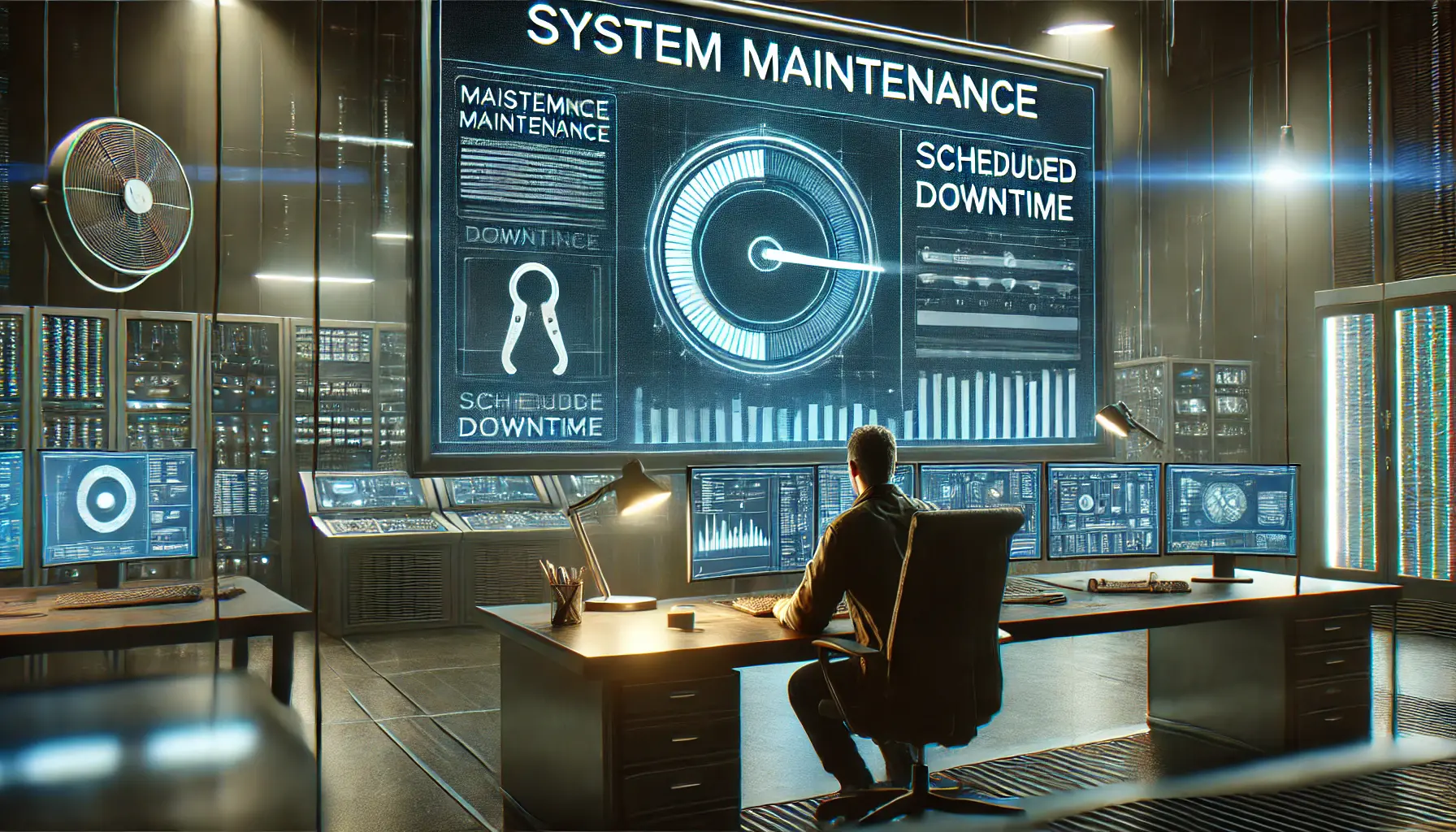
A control room showcasing the impact of system maintenance on digital ad services.
System Maintenance and Its Impact on Ad Services
Another common reason for short-term disruptions in Google Ads services pertains to routine maintenance.
During this time, some features might not be available.
While this is typically scheduled and communicated well in advance, it is essential to keep track of such events to avoid unnecessary panic.
Here are some tips to manage these situations:
- Review Google’s maintenance schedule to anticipate downtime.
- Pause time-sensitive campaigns if necessary.
- Prepare alternative strategies for critical campaign timelines.

A workspace illustrating how external factors, like connectivity issues and regional disruptions, influence Google Ads performance.
External Factors Affecting Google Ads Performance
Sometimes, external factors beyond Google’s control can lead to outages or disruptions in ad services.
These include:
- Internet connectivity issues impacting data transmission.
- Regional restrictions or outages affecting ad delivery.
- Third-party tools or plugins causing performance lags.
Understanding these external and internal factors that cause Google Ads outages will allow you to take informed steps toward resolving them quickly.
In the next section, we will discuss how to effectively monitor the status of the Google Ads system to stay up-to-date with outages and other associated incidents.
Understanding the root causes of outages is the first step to resolving them efficiently. Pay close attention to Google’s announcements and community discussions to identify potential technical issues.

A professional workspace for monitoring the Google Ads system status with real-time tools.
Monitoring Google Ads System Status
Staying informed about the operational status of Google Ads is crucial for maintaining the effectiveness of your advertising campaigns.
By proactively monitoring system status and setting up real-time alertsNotifications triggered by specific events or conditions to keep users informed., you can swiftly address any issues that arise, minimizing potential disruptions.

A professional setup showcasing the Google Ads Status Dashboard for monitoring service health.
Utilizing the Google Ads Status Dashboard
Google provides an official Status DashboardA user interface that provides an overview of key information and metrics. for Google Ads, which accurately reflects the current state of its services in real time.
This dashboard is an invaluable tool for identifying any outages or disruptions as they occur.
By regularly checking this page, you can:
- Confirm whether issues are general or specific to Google Ads services.
- Understand the scope and nature of reported problems.
- Receive updates on the resolution status of identified issues.
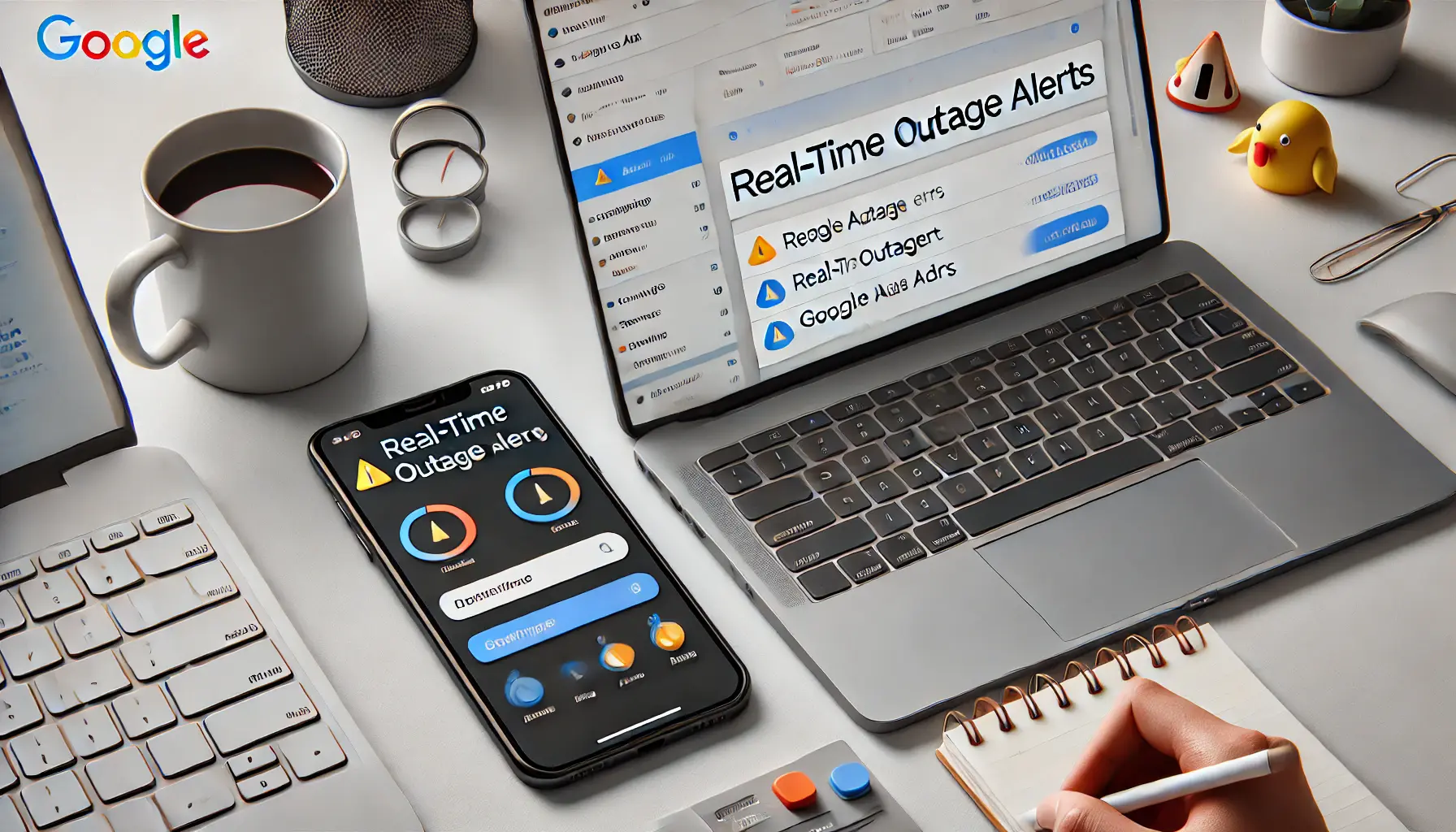
A setup for configuring real-time outage alerts to stay informed about Google Ads system status.
Setting Up Real-Time Outage Alerts
To ensure you are among the first to know when Google Ads services experience downtime, consider setting up real-time outage alerts.
While Google Ads offers in-account notifications for critical issues, third-partyAn external company or tool that is not directly affiliated with Google Ads. monitoring tools can enhance your awareness.
For instance, services like Uptime provide real-time notifications via email whenever their systems detect disruptions in Google Ads services.
By configuring these alerts, you can:
- Receive immediate notifications about service disruptions.
- Take swift action to mitigate the impact on your campaigns.
- Maintain transparency with stakeholders by providing timely updates.

A professional workspace for analyzing Google Ads status updates and incident reports.
Interpreting Status Updates and Incident Reports
When monitoring the status dashboard or receiving alerts, it is essential to accurately interpret the information provided.
Key distinctions to watch for include:
- Service Disruptions: Temporary issues affecting specific functionalities.
- Service Outages: Significant problems leading to the unavailability of certain services.
- Maintenance Notices: Scheduled maintenance periods that might temporarily affect service availability.
Understanding these distinctions enables you to determine the appropriate response and manage expectations during different types of incidents.
By staying updated with the operational health of Google Ads through monitoring and real-time alerts, you can proactively maintain the stability and performance of your advertising campaigns, even in the face of unexpected disruptions.
Regularly check the Google Ads Status Dashboard and set up real-time alerts to stay informed about any disruptions. This proactive approach ensures minimal campaign interruptions.

A workspace depicting immediate actions during a Google Ads outage.
Immediate Steps During a Google Ads Outage
Experiencing a Google Ads outage can be challenging, but taking prompt and strategic actions can help minimize disruptions to your advertising campaigns.
Here’s how you can effectively navigate such situations:
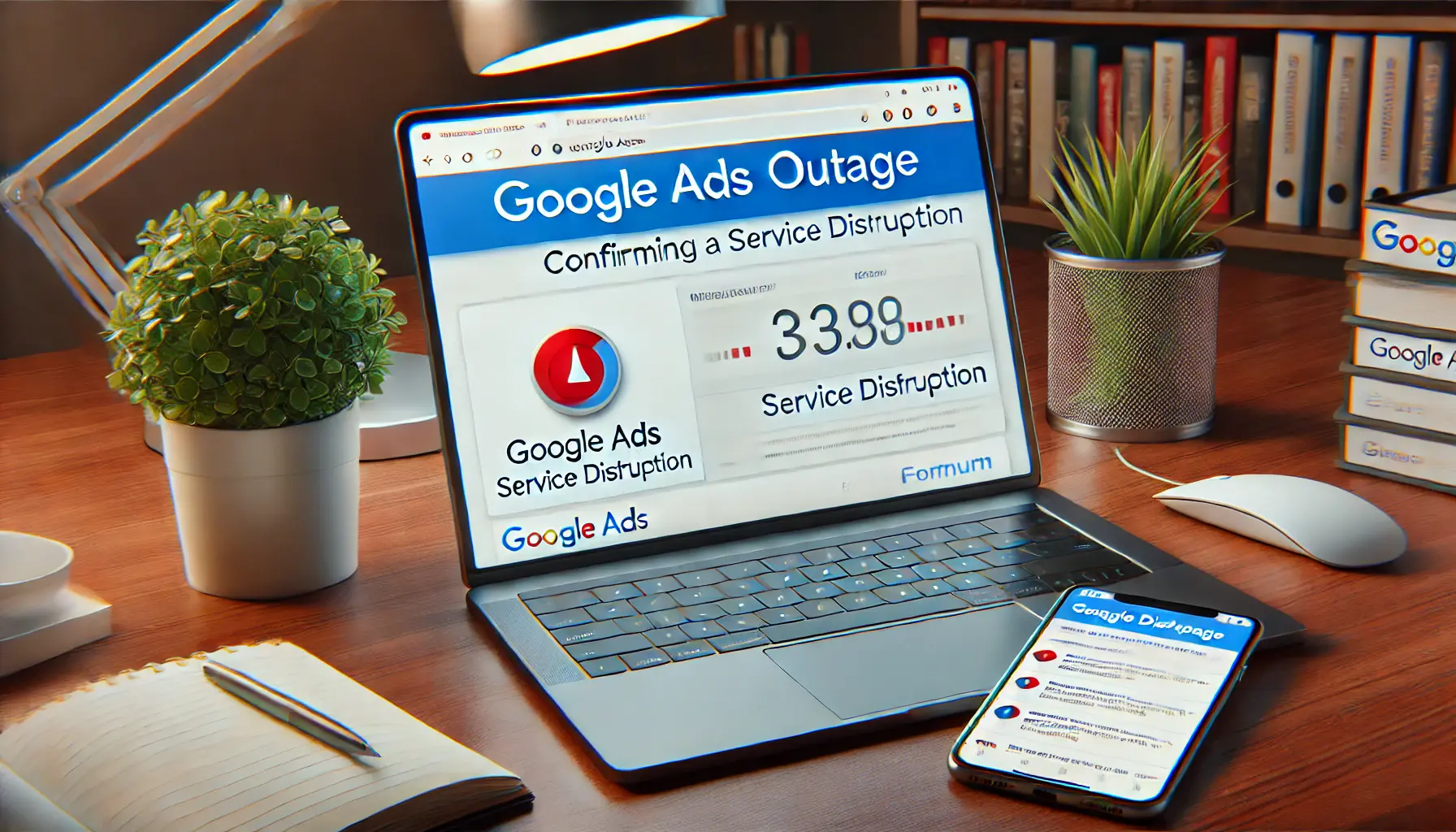
A workspace illustrating the process of confirming a Google Ads outage.
Confirm the Outage
Before taking any action, ensure that the issue isn’t isolated to your account:
- Check the Google Ads Status Dashboard for official updates on service disruptions.
- Visit community forums and social media platforms to see if other advertisers are reporting similar issues.
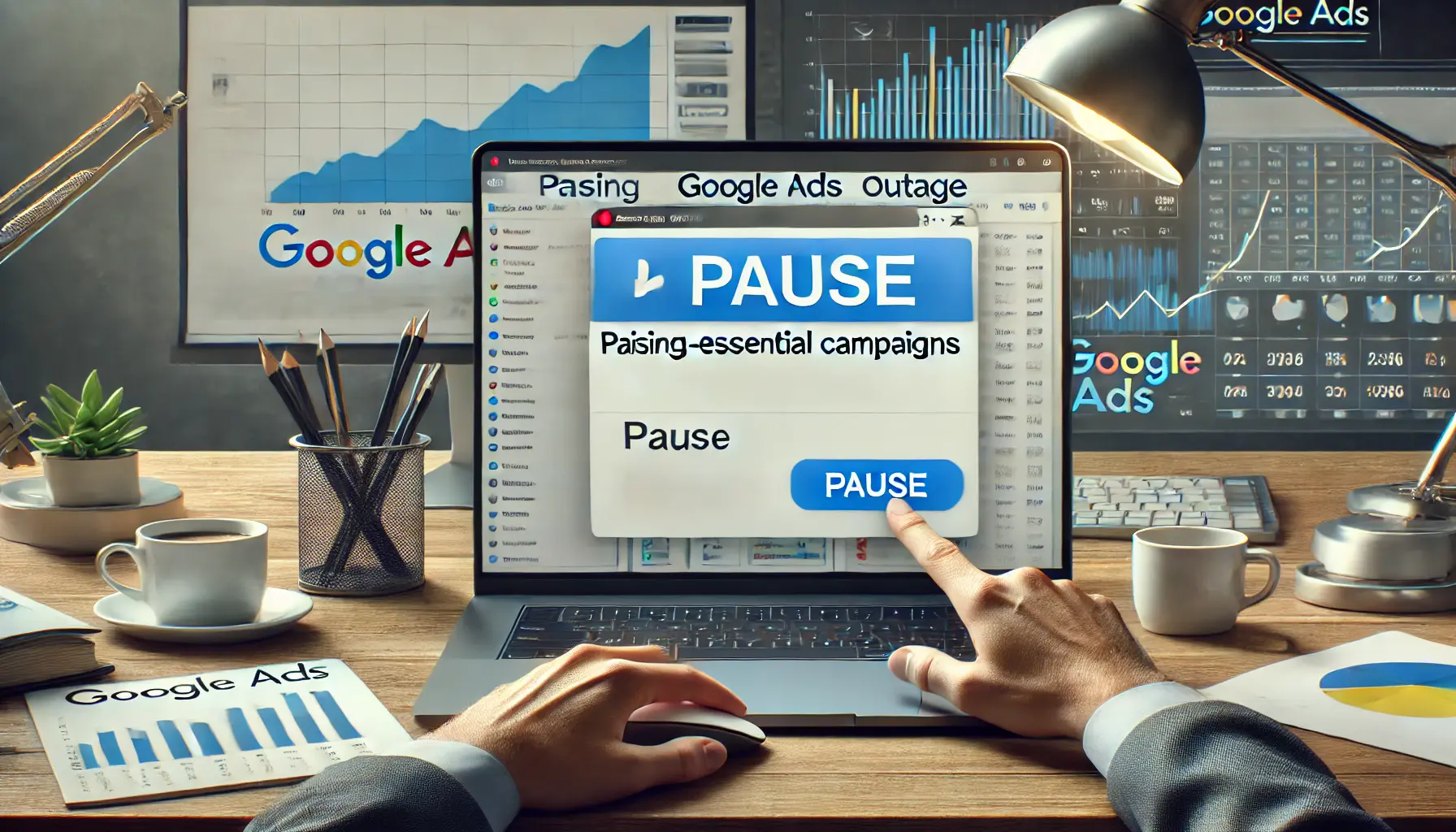
A workspace highlighting the process of pausing non-essential campaigns during an outage.
Pause Non-Essential Campaigns
If the outage affects your ability to monitor or control campaigns:
- Pause campaigns that are not time-sensitive to prevent unintended spending.
- Focus resources on critical campaigns that align with your immediate business goals.

A collaborative meeting to communicate with stakeholders during a Google Ads outage.
Communicate with Stakeholders
Maintain transparency with your team and clients:
- Inform relevant parties about the outage and its potential impact on campaign performance.
- Provide regular updates as new information becomes available.

A professional setup using alternative analytics tools during a Google Ads outage.
Utilize Alternative Analytics Tools
During the outage, access to Google Ads’ native reporting features may be limited:
- Use third-party analytics platforms to monitor website traffic and user engagement.
- Analyze data to assess whether your ads are still being served and identify any performance anomalies.
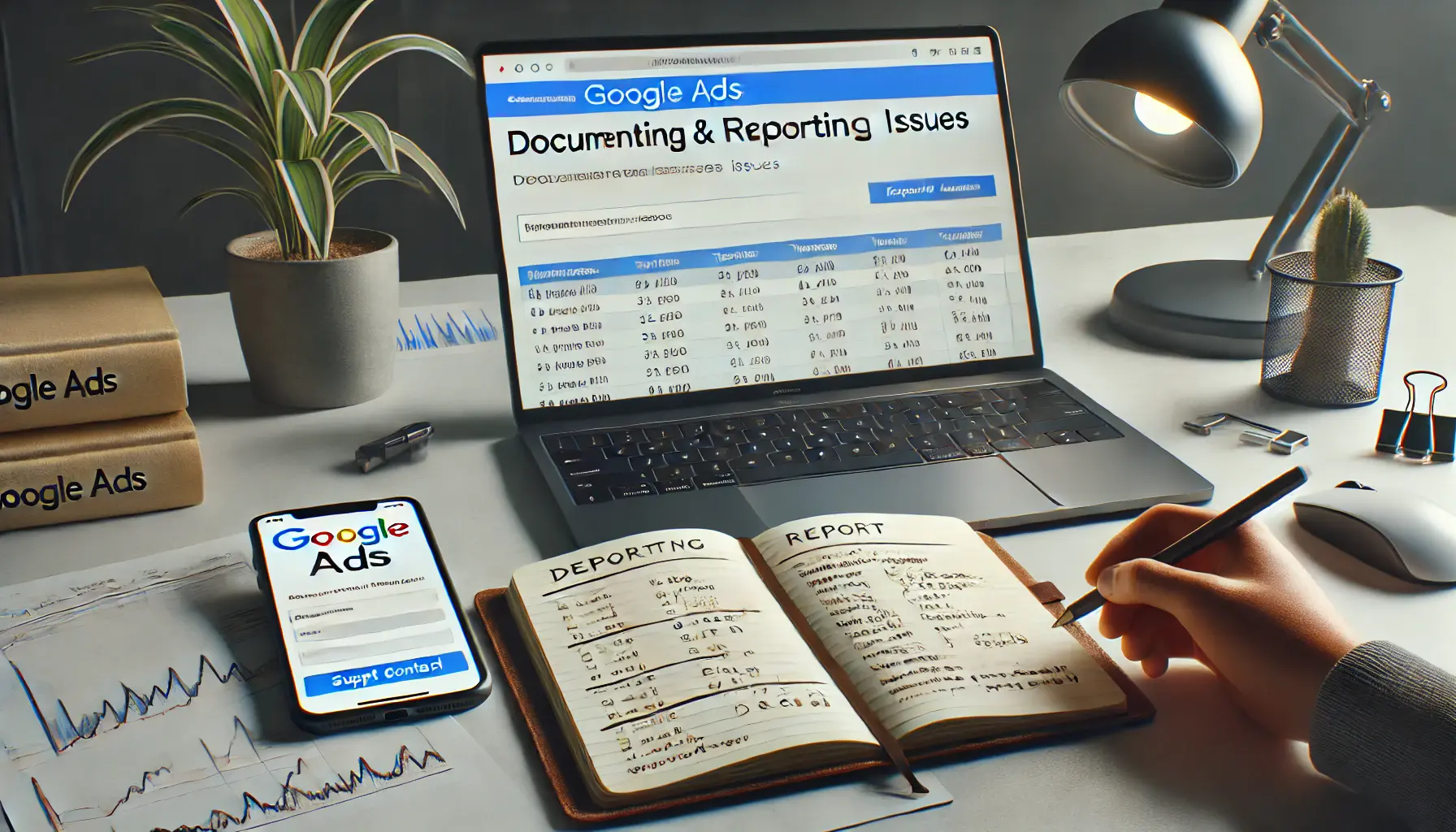
A workspace depicting the process of documenting and reporting issues during a Google Ads outage.
Document and Report Issues
Keeping detailed records can aid in troubleshooting and future preparedness:
- Note the time and nature of the issues encountered.
- Report these problems to Google Ads support to assist in their resolution efforts.
By implementing these steps, you can effectively manage your advertising efforts during a Google Ads outage, ensuring that your campaigns remain as stable and effective as possible under the circumstances.
During an outage, prioritize confirming the issue, pausing non-essential campaigns, and communicating with stakeholders to mitigate the impact on your advertising efforts.

A workspace focused on technical troubleshooting and restoring Google Ads campaigns post-outage.
Technical Troubleshooting Post-Outage
After a Google Ads outage, it’s essential to conduct thorough technical troubleshooting to ensure your campaigns return to optimal performance.
Here’s how you can systematically address potential issues:

A professional workspace for verifying account and campaign settings in Google Ads.
Verify Account and Campaign Settings
Outages can sometimes alter or reset account configurations.
To ensure everything is in order:
- Campaign Status: Confirm that all campaigns are active and have not been inadvertently paused.
- Ad Group and Ad Status: Ensure that ad groups and individual ads are enabled and properly configured.
- Targeting Settings: Review geographic, demographic, and audience targeting parameters to verify they align with your campaign objectives.

A workspace illustrating the process of checking Google Ads billing and payment information.
Check Billing and Payment Information
Billing issues can prevent ads from serving even after an outage is resolved.
To avoid disruptions:
- Verify that your payment methods are up-to-date and have sufficient funds.
- Look for any billing-related alerts or notifications in your Google Ads account.
- Review your billing history for any declined transactions or outstanding balances.

A workspace focused on assessing ad and keyword approvals in Google Ads campaigns.
Assess Ad and Keyword Approvals
Post-outage, some ads or keywords may face disapprovals due to policy changes or system errors.
To address this:
- Navigate to the Ads & Extensions section and filter for disapproved ads.
- Review the disapproval reasons and make necessary adjustments to comply with Google Ads policies.
- Resubmit the modified ads for approval.
- Check the Keywords tab for any keywords flagged for policy violations and take corrective actions.

A professional setup for closely monitoring Google Ads performance metrics.
Monitor Performance Metrics Closely
After an outage, it’s crucial to keep a close eye on your campaign performance to identify any lingering issues:
- Benchmark current performance metrics against historical data to find anomalies.
- Use Google Analytics or other tracking tools to monitor traffic patterns and user behavior on your site.
- Create custom alerts to notify you of sudden drops in critical metrics.
Performing these checks diligently will ensure that you quickly locate and fix issues that might have resulted from the outage, keeping your Google Ads running smoothly and effectively.
After an outage, systematically review campaign settings, billing information, and ad approvals to ensure all configurations are restored and optimized.
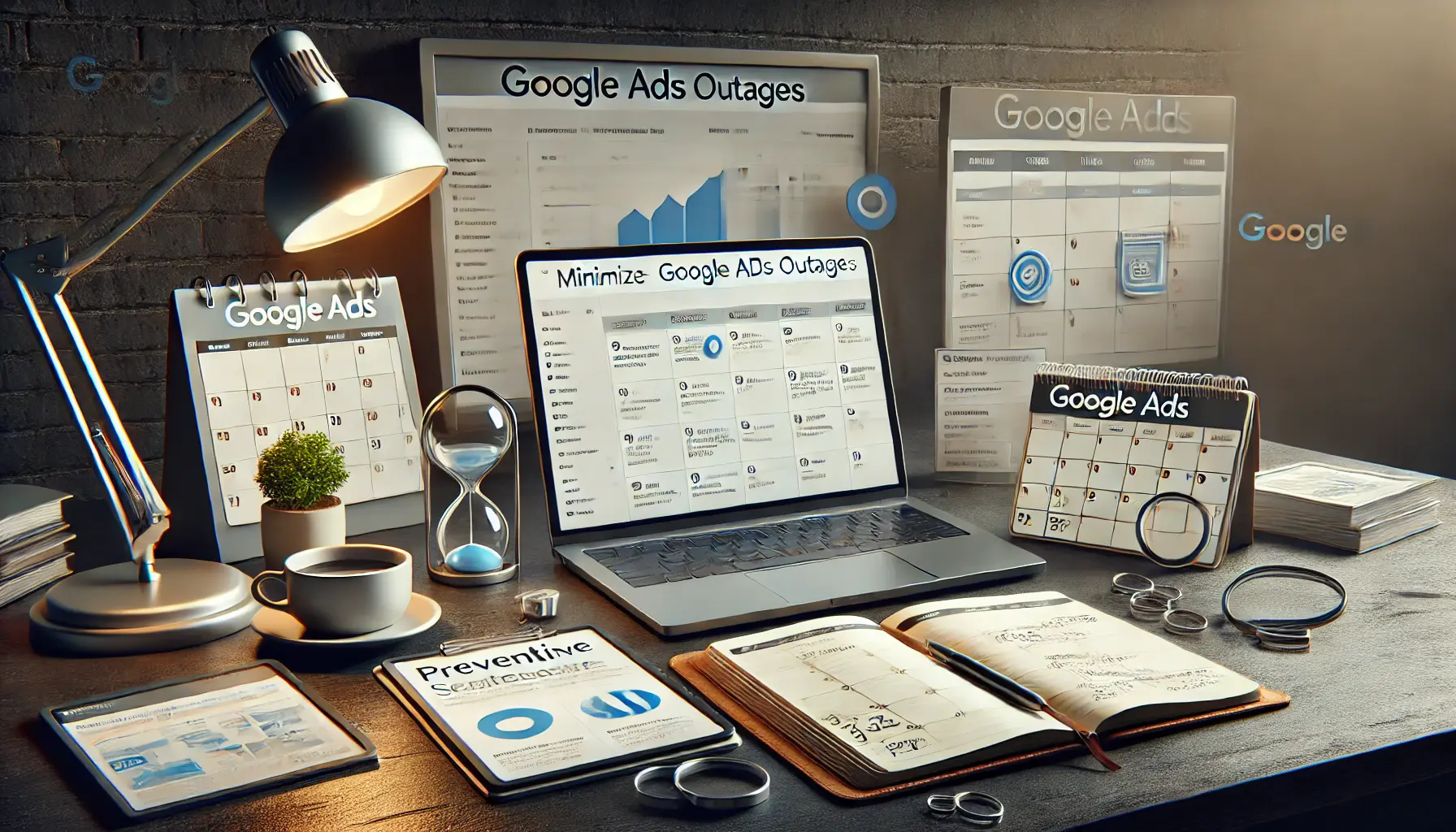
A workspace illustrating strategic preventive measures to ensure Google Ads campaign continuity.
Preventive Measures to Minimize Future Google Ads Outages
While it’s impossible to prevent all Google Ads outages, implementing proactive strategies can significantly reduce their impact on your advertising campaigns.
Here’s how you can fortify your operations against potential disruptions:

A workspace focused on regular monitoring of the Google Ads Status Dashboard for live updates.
Regularly Monitor the Google Ads Status Dashboard
Stay informed about the operational status of Google Ads by frequently checking the Google Ads Status Dashboard.
This tool provides real-time updates on service health, allowing you to anticipate and respond to issues promptly.
A workspace illustrating the process of implementing data exclusions for conversion tracking in Google Ads.
Implement Data Exclusions for Conversion Tracking
Conversion tracking issues can skew Smart BiddingThe process of setting a maximum cost for ads in pay-per-click advertising systems like Google Ads. strategies.
Utilize data exclusions to inform Smart Bidding of anomalies, helping maintain performance consistency during data outages.

A workspace illustrating the importance of staying informed about industry developments in digital marketing.
Stay Informed About Industry Developments
Keep up to date with news and updates about Google Ads.
Understanding the broader advertising ecosystem gives you insight into potential changes, enabling you to adjust your strategies accordingly.
By following these proactive steps, you can make your advertising campaigns more resilient to any sudden outage in Google Ads.
Adopt preventive strategies like monitoring the status dashboard, using data exclusions, and staying informed about industry developments to reduce future outage risks.

A workspace illustrating the resolution of a Google Ads outage and readiness for future challenges.
Final Thoughts on Resolving Google Ads Outage
Google Ads outages can be disruptive, but by employing a strategic approach, businesses can effectively minimize their impact and maintain campaign performance.
This article has outlined a step-by-step guide to identifying, addressing, and preventing Google Ads outages, ensuring your marketing efforts remain on track even during challenging times.

A workspace summarizing key takeaways from resolving a Google Ads outage.
Key Takeaways
- Causes of Outages: Recognize the root causes, including technical issues, system maintenance, and external factors, that determine the reason for an outage in Google Ads. Understanding these causes can enable you to respond appropriately and efficiently.
- System Status Monitoring: Continuously monitor the Google Ads Status Dashboard, with real-time alerts set up to keep you updated on operational health.
- Actions Upon Outages: Confirm the outage, inform your stakeholders, and find alternative tools to reduce disruption while maintaining maximum transparency over your accounts.
- Troubleshooting After an Outage: Check account settings, review billing, assess ad and keyword approvals, and monitor performance metrics to restore your campaigns effectively.
- Preventive Measures: Adopt proactive strategies, such as monitoring updates, implementing data exclusions, and staying informed about industry developments, to reduce the likelihood and impact of future outages.

A workspace illustrating strategic planning to build resilience for future challenges in digital marketing.
Building Resilience for Future Challenges
Preparing for potential Google Ads outages requires a combination of vigilance, adaptability, and strategic planning.
By following the practices outlined in this article, you can ensure your advertising campaigns remain resilient, even in the face of unexpected disruptions.
These measures not only protect your marketing investments but also help you nurture strong relationships with clients and stakeholders through continuous communication and performance.
The digital advertising space is ever-changing and requires you to stay up-to-date with the latest news and adopt a proactive mindset.
Use the tools and strategies discussed here to ensure your campaigns thrive despite challenges posed by Google Ads outages.
By implementing strategic monitoring, troubleshooting, and preventive measures, you can maintain resilience and ensure consistent campaign performance even during outages.
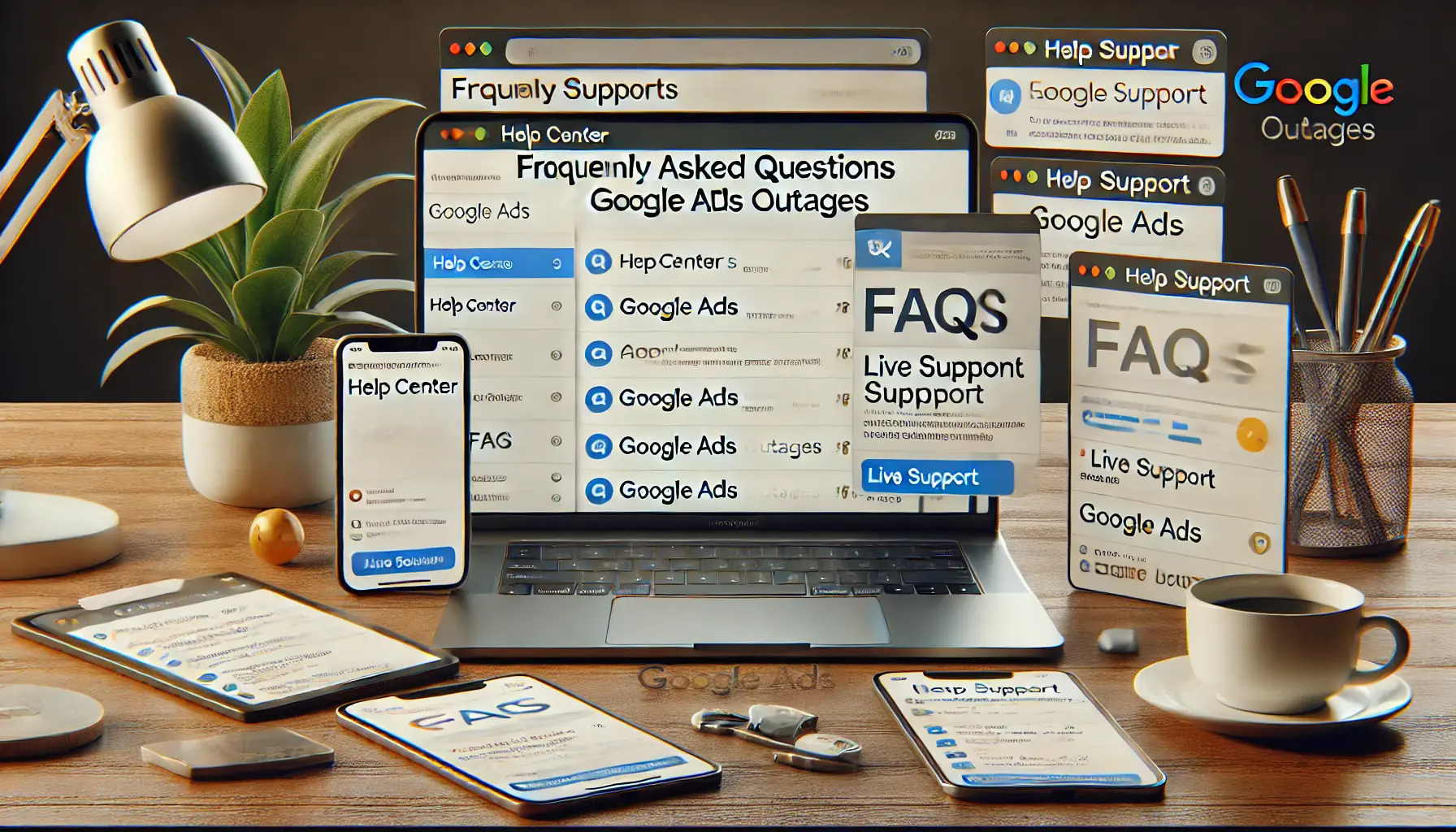
A workspace symbolizing the proactive approach to addressing frequently asked questions about Google Ads outages.
Your campaigns can be managed by an agency specialized in Google Ads, check out our service page.
Frequently Asked Questions About Google Ads Outages
The Google Ads Status Dashboard provides real-time information on the operational status of Google Ads services, helping users identify any ongoing outages or disruptions.
To verify if Google Ads is down, visit the Google Ads Status Dashboard, which offers up-to-date information on service availability and any reported issues.
If you suspect an outage, first check the Google Ads Status Dashboard.
If no issues are reported, consider reaching out to Google Ads Support for assistance.
Google Ads outages are relatively infrequent.
However, when they do occur, they are typically resolved promptly to minimize disruption to advertisers.
Yes, you can subscribe to updates from the Google Ads Status Dashboard or use third-party monitoring services to receive real-time notifications about outages.
To mitigate the impact of potential outages, consider diversifying your advertising platforms and establishing contingency plans to maintain campaign continuity.
Historical data on Google Ads outages can be found on the Google Ads Status Dashboard, which archives past incidents and their resolutions.
Not necessarily.
Some outages may be localized or affect only specific services within Google Ads, while others could have a broader impact.
The duration of Google Ads outages varies depending on the nature of the issue.
Google strives to resolve disruptions as quickly as possible to restore normal service.










